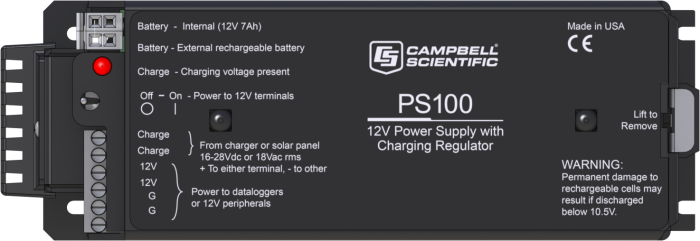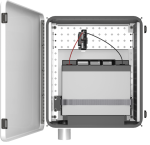This product is not available for new orders.

| Services disponibles | |
|---|---|
| Réparation | No |
| Etalonnage | No |
| Support gratuit | No |
Aperçu
L'alimentation rechargeable PS100 délivre une tension de 12 Vcc, 7 Ah destinée aux périphériques et aux centrales de mesure CR500, CR510, CR800, CR850, CR10, CR10X et CR1000. La batterie rechargeable peut être rechargée via une alimentation secteur (nécessite un adaptateur secteur de type, AC-ADAPT en option) ou à partir d'un panneau solaire externe. L'utilisateur peut ajouter une batterie rechargeable externe.
Lire la suiteImages








Fichiers 3D/CAD :
Description technique
Le PS100 peut également être utilisé comme un bloc d'alimentation distinct auxiliaire de 12 V destiné aux capteurs ou à des périphériques situés à distance, par exemple un multiplexeur placé à certaine une distance du coffret de la centrale de mesure. Toutefois, pour éviter les erreurs de mesure analogiques et les boucles de masse, les 0 du 12V des alimentations doivent être reliés.
Le PS100 remplace l'alimentation PS12E-LA. Le PS100 est de dimension légèrement plus petit que le PS12-LA. Il permet également l'accès à l'interrupteur d'alimentation et la LED sans enlever le couvercle de l'alimentation.
Compatibilité
Veuillez noter : Ce qui suit montre des informations de compatibilité générales. Ce n'est pas une liste complète de tous les produits compatibles.
Centrale de mesure
| Produits | Compatibilité | Note |
|---|---|---|
| CR1000 (obsolète) | ||
| CR200X (obsolète) | ||
| CR216X (obsolète) | ||
| CR3000 (obsolète) | Typically, a CR23X, CR3000, or CR5000 datalogger uses its integrated rechargeable base instead of the PS100. However, the PS100 can be used if the data logger has a low-profile base or if the battery base has been disconnected. | |
| CR5000 (obsolète) | Typically, a CR23X, CR3000, or CR5000 datalogger uses its integrated rechargeable base instead of the PS100. However, the PS100 can be used if the data logger has a low-profile base or if the battery base has been disconnected. | |
| CR6 | ||
| CR800 (obsolète) | ||
| CR850 (obsolète) | ||
| CR9000X (obsolète) |
Divers
| Produits | Compatibilité | Note |
|---|---|---|
| 34029 |
Informations de compatibilité supplémentaires
Enclosure Considerations
A desiccated, non-condensing environment is required. The PS100 includes built-in keyhole flanges for mounting to the backplate of a Campbell Scientific enclosure.
Adapters
The PS100 is compatible with the A100 null-modem adapter and the A105 adapter for additional 12 V output terminals. The A100 Null Modem Adapter connects and powers two Campbell Scientific peripherals via two CS I/O 9-pin connectors configured as a null modem. This is useful in linking different communications technologies, such as telephone to radio, at sites that do not have a data logger. The A105 adapter may be used to provide additional 12 V and ground terminals where the power supply is used to power several devices.
Charging Source
The PS100 charges with a 24 V input. However, when the battery is discharged or the system is pulling high current (about 700 mA), the regulator overheats. This, in turn, limits the charging time because the regulator is heating up until it gets so hot that it shuts down. At this point, the regulator stops charging the battery until the regulator cools down and starts charging again. This cycle repeats until the battery is charged enough so that the regulator no longer overheats. For a system with a constant current drain of 0.7 A or higher, the PS100 is not able to keep the battery charged unless the input voltage is between 16 and 20 V. If the input voltage is between 16 and 20 V, the regulator outputs continuously up to a 1.2 A load.
Spécifications
| input Voltage (CHG Terminals) | 15 to 28 Vdc or 18 Vac RMS |
| Charging Output Voltage | Temperature compensated float charge (for 12 V battery) |
| Output Limit (12V and G Terminals) | 3.0 A (temperature dependent) |
| Charging Current Limit | 1.2 A (typical) |
| Power Out (+12 Terminals) Voltage | Unregulated 12 V (from battery) |
| Nominal Rating | 7 Ah |
| Dimensions | 10.5 x 19.3 x 7.1 cm (4.1 x 7.6 x 2.8 in.) including mounts and connectors |
| Weight | 3.1 kg (6.9 lb) |
| Battery Weight | 2.7 kg (5.9 lb) |
Quiescent Current |
|
| Charge Source Present | 3 to 5 mA |
| No Charge Source Present | 0 mA |
Documents à télécharger
Brochures
Notes techniques
Vidéos & Tutoriels
FAQ
Nombre de FAQ au sujet de(s) PS100: 32
Développer toutRéduire tout
-
The PS100, PS150, and PS200 models take in AC or DC power from a wall transformer or a solar panel. The internal regulator controls the charge to the battery to make sure the battery doesn’t become overcharged (based on temperature).
If the switch is on, the voltage from the battery will flow back out from the regulated battery to the loads; however, the voltage on that battery may be 11.9 V, 13.2 V, or some other value that the battery happens to be at. It is important to understand that the voltage will not always be exactly 12.0 Vdc. Rather, the voltage will float up or down as the battery is recharged or depleted.
-
Yes. The G and 12V terminals on the charge regulator are used to connect the black and red wires that connect with the green connector, which provides power to the data logger.
-
Most would terminate the ac line in an ordinary duplex receptacle box inside the enclosure. It is not recommended that you use the same conduit access hole that your signal leads are fed through, as that may induce unwanted noise in your signals. Then, simply connect the 9591 wall transformer from the receptacle to the PS100 charge terminals. The PS100 (or CH100) expects either 18 Vac or 18 Vdc that's limited to no more than 1.2 amps.
-
Yes. However, Campbell Scientific recommends connecting a PS100 battery to a wall charger overnight before using it in the field.
-
No. The sole purpose of the red LED on the PS100 is to indicate that the solar panel or ac wall transformer is delivering power to the charge circuitry.
-
Campbell Scientific recommends letting an idle PS100 charge continuously in an ac power setting. If solar panel power is being used, the daily cycle is expected.
-
The LED will be off if the solar panel is missing or damaged, or if it is night-time. If the charging source is a wall charger, such as a 29796, the issue could be a loose connection, a power failure, or a bad wall transformer. To check the connection, try tightening the screws. To check for a power failure, try plugging another device into the wall outlet.
-
-
Not directly. However, a DCDC18R Boost Regulator can be used to boost the voltage of the 12 V, 100 Ah battery up to the required 18 V.
-
Yes, but the heat sink on the PS100 may get warm, so be careful. An older Campbell Scientific charger that is 15 to 18 Vac or Vdc may run cooler. To charge from a 24 Vdc power source, Campbell Scientific recommends using the PS150, CH150, PS200, CH200 or CH201.
The 29796 or 22110 can be used with the PS100 if it limited to an "average current of no more than 0.25 A." Short-term peak currents can exceed 1 A without problem.
Applications
Korea Expressway Corporation (KEC) a été créé en 1969 pour construire et gérer les autoroutes à......En savoir plus
Le Solar Decathlon est une compétition qui a lieu tous les deux ans sur le......En savoir plus
The Mount Washington Observatory in New Hampshire is one of the oldest weather observatories in......En savoir plus






